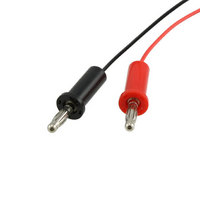AC002023 Microchip Technology, AC002023 Datasheet - Page 26

AC002023
Manufacturer Part Number
AC002023
Description
CURRENT MEASUREMENT CABLE
Manufacturer
Microchip Technology
Datasheet
1.PIC24FJ64GA104-IPT.pdf
(36 pages)
Specifications of AC002023
Accessory Type
Measurement Cable
Processor To Be Evaluated
PIC Family
Processor Series
PICxxFIxxx
Lead Free Status / RoHS Status
Lead free / RoHS Compliant
For Use With/related Products
XLP Development Boards
Lead Free Status / Rohs Status
Lead free / RoHS Compliant
For Use With
XLP Development Boards
Lead Free Status / RoHS Status
Lead free / RoHS Compliant, Lead free / RoHS Compliant
Available stocks
Company
Part Number
Manufacturer
Quantity
Price
Company:
Part Number:
AC002023
Manufacturer:
Microchip Technology
Quantity:
135
Company:
Part Number:
AC002023
Manufacturer:
MICROCHIP
Quantity:
12 000
DS51873B-page 26
3.2.12
The socket, labeled “Cap Sense”, permits the easy connection of a capacitive load to
the input of the Charge Time Measurement Unit (CTMU). It connects to analog input,
AN0, for 28-pin devices and AN10 for 20-pin devices. It can be used to demonstrate
CTMU measurements for capacitance, time and voltage. For additional information on
measuring capacitance with the CTMU, refer to Section 11. “Charge Time
Measurement Unit (CTMU)” (DS39724) of the “PIC24F Family Reference Manual”.
3.2.13
The 16-bit XLP board includes a PIC18F14K50 USB microcontroller (U2) which pro-
vides USB connectivity and UART-to-USB protocol translation. The PIC18F14K50 is
hard-wired to the PIC24F RX and TX pins, and communicates with the PIC24F device
through its UART. The USB UART translation software is available in the USB stack
release.
The PIC18F14K50 is clocked independently from the PIC24F microcontroller. It uses
its own 12 MHz crystal (Y3).
3.2.14
The XLP 16-bit board supports two types of RS-232 transceivers and associated sup-
port circuitry through a standard DB9 connector. This port is configured as a DCE
device and can be connected to a PC using a straight-through cable. Hardware flow
control is not supported. As shipped, the serial port circuitry and DB9 connector are not
populated; instead, USB is used to communicate to the host PC.
By supporting two transceivers, the user can choose between a low-cost solution
based on the MAX3221 (3.0V to 5.5V) or a wide voltage range (1.8V to 5.5V) solution
using the LTC2801. For operation at the low end of the board’s V
2.0V), the MAX2331 is below its minimum specified operating voltage. It is
recommended that the LTC2801 circuit be populated in this circumstance.
The PIC24F microcontroller’s TX and RX pins are also connected to the PIC18F14K50
RX and TX pins, and are used to convert the UART communication to USB. When the
RS-232 option is implemented, remove the zero ohm resistor, R27, to avoid contention
with the PIC18F14K50.
3.2.15
The XLP 16-bit board implements a 28-pin modular expansion interface (J7).
Although physically similar to the PICtail™ interface available on many Microchip
demo and development boards, it does not implement the full range of signals sup-
ported by the PICtail interface. The connector pin assignments for J7 are shown in
Appendix A. “Development Kit Schematics”.
The XLP board’s interface allows the board to provide basic generic functionality to
select PICtail modules (listed below), and also be forward compatible with new PICtail
technologies. The user will need to review new modules as they become available to
determine their compatibility with the XLP 16-bit board.
In order to use the software for compatible PICtail modules, the pin assignments
defined in software will need to be remapped to those implemented in the interface.
This typically requires minor changes to the header file (.h) of the software stack.
Note 1:
2:
Capacitive Sense Socket
USB Connectivity
RS-232 Serial Port Options
Modular Expansion Connector
The 100 k potentiometer is multiplexed with pin 19 of the connector. It
is recommended to turn the potentiometer to its highest resistance setting
to minimize the load on that pin’s signal.
Due to the limited availability of I/O ports on 20-pin PIC24F devices, the
modular expansion interface does not support these devices.
2010 Microchip Technology Inc.
DD
range (1.8V to












